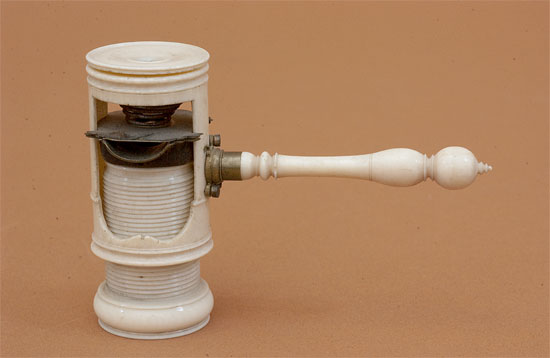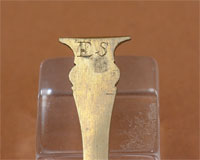 |
|||||
 |
 |
||||
 |
|||||
 |
 |
||||



This instrument in the Golub Collection is especially rare because it is a complete set as manufactured by Scarlett; including two instruction manuals, one in English the other in French. Interstingly, the forceps plus Black/White disc included as an accessory to this Scarlett set appears to have been made by Edmund Culpeper. The set can be stored in a wood case covered in blackened ray skin. 2 3/4"
The following is Edward Scarlett's Description and Use of this instrument. Refer to Scarlett's diagram.
This set of Microscopes has seven different magnifying glasses, Six of which may be used with two different Instruments, for the better applying them to various Objects. The Body of the Instrument, is represented CB, made of Silver, Brass or Ivory; it hath three thin Brass Plates EE, and a Spring of Steel H within it: To one of these thin Plates of Brass is fixed a piece of Leather F with a small Furrow G, both in the Leather and Brass to which it is fixed. In one end of this Instrument there is a long Screw, D, with a Convex Glass C placed in the end of it: In the other end there is a hollow Screw o o, wherein any of the Magnifying Glasses M are screw’d when they are to be made use of. The six different Magnifying Glasses are all set in the manner express’d at M. The greater Magnifyer is mark’d upon the Silver, Brass or Ivory, wherein it is set with No 1. the next 2. and so on to 6; the 7th Glass is mark’d 7, and set in the manner of a little Barrel, as N.
O. is a flat piece of Ivory, whereof four belong to this set of Microscopes, (tho’ any one who has a mind to keep a Register of Objects, may have as many of them as he pleases) in each of which there are 4 holes d d d d, wherein the several Objects are placed, between 2 thin Glasses or Talks.
The other Instrument P. is made of Brass to slide in between the Brass Plates E, of the Instrument C B, with a small pair of Tongs V at the end, which opens by pressing together the two Heads of he Pins, for taking up of Objects. At the other end of this Instrument is a Point or Needle N. to prick any Object upon. Upon that Point of the Instrument P, is screwed a round piece of Brass expres’d at H, with a piece of Ivory and lack Wood fix’d in it, to put and Opake Object on according to the difference of their Colour; there are two little Points or Springs which turn down, to keep the Objects from falling off.
The Instrument R. has a Screw at R, which Screws on the Body of the Microscope, at the hollow Screw o o unto which is fixt a Ring of Brass Q, which moves backward and forward, on a Center, as the Object requires. In that Ring there is a Screw, which receives all the Glasses M, so that when any Object is taken up in the Points of the Tongs V, or laid up on the other end (which is to be useful for Opack Bodies) it may very easily be applyed to the true distance of any of the Glasses M, by means of the Screw D, which will bring the Object to the exact distance.
Featured 1/2011